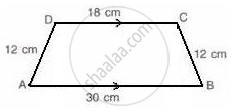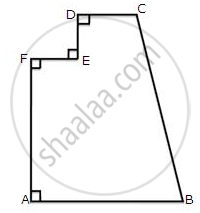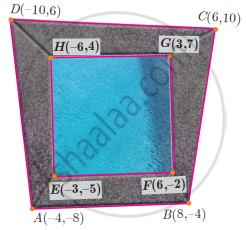Advertisements
Advertisements
प्रश्न
The perimeter of a rhombus is 52 cm. If one diagonal is 24 cm; find:
(i) The length of its other diagonal,
(ii) Its area.
उत्तर
Let a be the length of each side of the rhombus.
4a = perimeter
4a = 52
a = 13 cm
(i) It is given that,
AC= 24 cm
We have to find BD.
Now
`a^2 = ( "AC"/2 )^2 + ( "BD"/2)^2`
`13^2 = 12^2 + ("BD"/2)^2`
`( "BD"/2 )^2 = 5^2`
BD = 10 cm
Hence the other diagonal is 10cm.
(ii) Area of the rhombus = `1/2` x AC x BD
= `1/2` x 24 x 10
= 120 sq.cm.
APPEARS IN
संबंधित प्रश्न
Trapezium given below; find its area.

Trapezium given below; find its area.
The figure given below shows the cross-section of a concrete structure. Calculate the area of cross-section if AB = 1.8 cm, CD = 0.6 m, DE = 0.8 m, EF = 0.3 m and AF = 1.2 m.

The area of a rhombus is 216 sq. cm. If it's one diagonal is 24 cm; find:
(i) Length of its other diagonal,
(ii) Length of its side,
(iii) The perimeter of the rhombus.
A floor that measures 15 m x 8 m is to be laid with tiles measuring 50 cm x 25 cm. Find the number of tiles required.
Further, if a carpet is laid on the floor so that a space of 1 m exists between its edges and the edges of the floor, what fraction of the floor is left uncovered?
Find the diagonal of a quadrilateral whose area is 756cm2 and the perpendicular from the opposite vertices are 17cm and 19cm.
In the following, find the value of ‘a’ for which the given points are collinear
(a, 2 – 2a), (– a + 1, 2a) and (– 4 – a, 6 – 2a)
The quadrilateral swimming pool shown is surrounded by concrete patio. Find the area of the patio
When proving that a quadrilateral is a trapezium, it is necessary to show
If the diagonal d of a quadrilateral is doubled and the heights h1 and h2 falling on d are halved, then the area of quadrilateral is ______.
